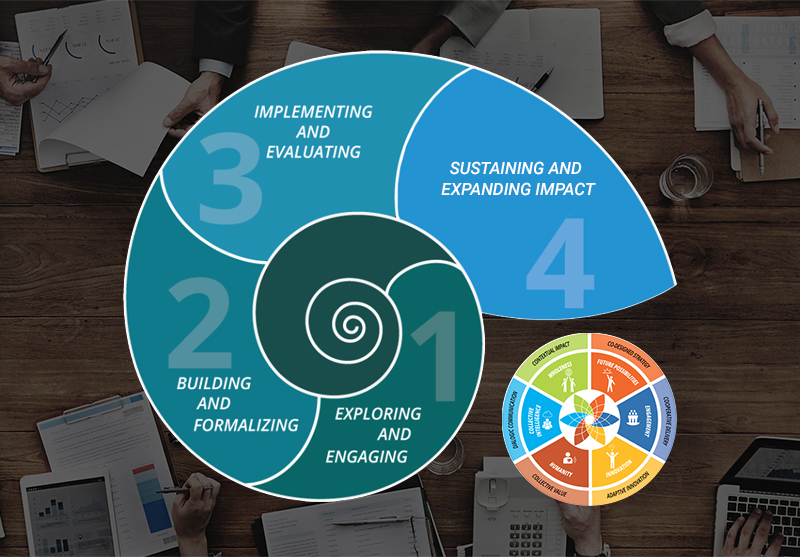The key to success in complex multi-stakeholder collaboration is regular reflection among key actors about achieved results as well as about the quality of the collaboration patterns, as this has a direct effect on results. Establishing a learning culture needs to be developed right from the start. The purpose of process monitoring is to keep track of the quality of the process architecture and key success factors.
Process-monitoring is best done in the form of a collective assessment based on the collaboration catalysts as success factors for Collaboration Ecosystems that can deliver.
While process monitoring can start early in a collaboration (in Phase 1 phase 2) it is best done when the transformative change envisaged has yielded the first results in phase 3.


Process-monitoring is best done in the form of an individual or collective assessment based on the collaboration catalysts as success factors for Collaboration Ecosystems that can deliver.
While process monitoring can start early in a collaboration (in Phase 1 phase 2) it is best done when the transformative change envisaged has yielded the first results in PHASE 3.
The Collaboration Catalysts are indicators for the quality of process architectures in multi-stakeholder collaboration.
Co-designed Strategy belongs to the Compass dimension of FUTURE POSSIBILITIES. It means ensuring that over time all relevant stakeholders drive strategy and implementation as a functional collaboration ecosystem. It is enhanced by goal clarity, inclusivity and accountability.
What can you do to enhance GOAL CLARITY ?
What can you do to enhance INCLUSIVITY ?
What can you do to enhance ACCOUNTABILITY ?
Multi-stakeholder collaboration taps into people's desire to collectively shape the future. The development of vision and strategies is a multi-layered process that begins with a core group, but eventually needs to include all relevant stakeholders.
Cooperative Delivery belongs to the Compass dimension of ENGAGEMENT. It means ensuring ownership and result-orientation of the collaboration ecosystem through well organized engagement of stakeholders. It is enhanced by quality engagement management, network building and result-orientation.
What can you do to enhance ENGAGEMENT MANAGEMENT ?
What can you do to enhance NETWORK BUILDING ?
What can you do to enhance RESULT ORIENTATION ?
Multi-stakeholder initiatives need to build cohesive collaboration systems around issues of common concern. Clarity on process planning, strategic alignment of all partners, and professional process management provide the basic level of certainty that people require to stay engaged.
Adaptive Innovation belongs to the Compass dimension of INNOVATION. . It means ensuring novel pathways of the collaboration ecosystem through co-creation of transformation prototypes and attention to emergent opportunities and concerns. It is enhanced by creative prototyping, knowledge management and planning flexibility.
What can you do to enhance CREATIVE PROTOTYPING ?
What can you do to enhance KNOWLEDGE MANAGEMENT ?
What can you do to enhance PLANNING FLEXIBILITY ?
Multi-stakeholder collaboration fosters the human longing for new pathways and innovative solutions to existing challenges. Providing state-of-the-art knowledge, content expertise, and creative learning exchanges become the fertile ground for prototyping new approaches.
Collective Value belongs to the Compass dimension of HUMANITY. . t means ensuring that the transformative change process creates value for all stakeholders in the collaboration ecosystem. It is enhanced by appreciative approaches, balancing power and mutual understanding.
What can you do to enhance APPRECIATIVE APPROACHES ?
What can you do to enhance BALANCING POWER ?
What can you do to enhance MUTUAL UNDERSTANDING ?
Multi-stakeholder initiatives are built on people's growing sense of responsibility for the future and a common purpose that transcends vested interests. To keep people engaged, process designs must enable actors to converse about their interests and power differences.
Dialogic Communication belongs to the Compass dimension of COLLECTIVE INTELLIGENCE.. It means ensuring communication architectures that acknowledge diversity and create cohesion in the collaboration ecosystem. It is enhanced by structured dialogue, governance and collective learning.
What can you do to enhance STRUCTURED DIALOGUE ?
What can you do to enhance GOVERNANCE ?
What can you do to enhance COLLECTIVE LEARNING ?
Multi-stakeholder initiatives build new human interaction systems across the boundaries of societal sectors and institutions. Trust develops through structured dialogue and progress is not built on persuading others to follow a predefined goal, but rather the willingness to negotiate pathways into the future.
Contextual Impact belongs to the Compass dimension of WHOLENESS.. It means ensuring the relevance for and the embeddedness of the collaboration ecosystem in larger transformations. It is enhanced by context relevance, capacity building and impact focus.
What can you do to enhance CONTEXT RELEVANCE ?
What can you do to enhance CAPACITY BUILDING ?
What can you do to enhance IMPACT FOCUS ?
Multi-stakeholder initiatives focus on tangible outcomes as well as the wider impact. Appropriate context management, continues capacity development, and regularly reviewed contextual contributions to a larger system of transformation are key to success.